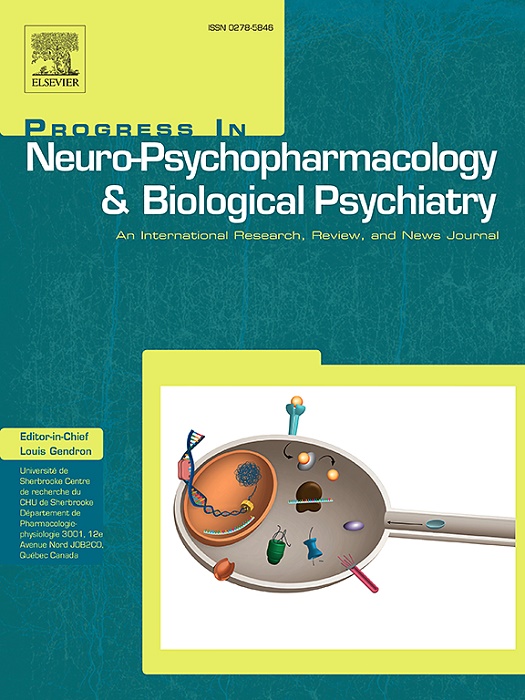Genetic variation of the estrogen receptor and its association with depression and anxiety symptoms in young females
IF 3.9
2区 医学
Q1 CLINICAL NEUROLOGY
Progress in Neuro-Psychopharmacology & Biological Psychiatry
Pub Date : 2025-09-05
DOI:10.1016/j.pnpbp.2025.111485
引用次数: 0
Abstract
Estrogens are suggested to affect mood by binding to widespread estrogen receptors in the brain and therewith modulating a variety of neurosignaling pathways. Single nucleotide polymorphisms (SNPs) in the genes encoding estrogen receptors might influence these actions and thereby play a role in the genetic foundation of mood disorders. Several SNPs in the estrogen receptor 1 (ESR1) gene have been studied in relation to anxiety and depression, while confounders and interaction with psychosocial factors have largely been overlooked. The present study investigated the effect of the functional polymorphisms rs2234693 (PvuII) and rs9340799 (XbaI) in the ESR1 gene on depression and anxiety symptoms as well as their interaction with early life adversities and parenting in two independent female cohorts, considering relevant confounding factors. In adolescent females (n = 1036), the rs9340799 minor allele (G) was found to protect against increasing anxiety symptoms from age 14 to 17, whereas, in young adult females (n = 1314, mean age: 22.2 years), it was associated with a greater risk of experiencing above-threshold anxiety symptoms. No genetic effect was found for rs2234693 and depressive symptoms in either cohort. A significant three-way gene-environment interaction was observed between rs9340799, stressful early life events, and supportive parenting on anxiety symptoms in female adolescents. These findings suggest a potential differential plasticity of the G allele in relation to anxiety symptoms in female youth. By incorporating longitudinal assessments and gene-environment analyses, this study contributes to the literature on internalizing symptoms in females in the context of estrogen-related constitutive vulnerability.
年轻女性雌激素受体的遗传可塑性及其与抑郁和焦虑症状的关系
雌激素被认为通过与大脑中广泛存在的雌激素受体结合,从而调节各种神经信号通路,从而影响情绪。雌激素受体编码基因中的单核苷酸多态性(snp)可能影响这些行为,从而在情绪障碍的遗传基础中发挥作用。雌激素受体1 (ESR1)基因中的几个snp与焦虑和抑郁的关系已经被研究,而混杂因素和与社会心理因素的相互作用在很大程度上被忽视了。本研究在考虑相关混杂因素的情况下,研究了ESR1基因功能多态性rs2234693 (PvuII)和rs9340799 (XbaI)在两个独立女性队列中对抑郁和焦虑症状的影响,以及它们与早期生活逆境和父母教养的相互作用。在青春期女性(n = 1036)中,发现rs9340799小等位基因(G)可以防止14岁至17岁期间焦虑症状的增加,而在年轻成年女性(n = 1314,平均年龄:22.2 岁)中,它与经历高于阈值的焦虑症状的更大风险相关。在两个队列中均未发现rs2234693和抑郁症状的遗传效应。rs9340799、早期生活压力事件和支持性父母教养对女性青少年焦虑症状的影响存在显著的基因-环境三方交互作用。这些发现表明,G等位基因的潜在差异可塑性与女性青年的焦虑症状有关。通过结合纵向评估和基因环境分析,本研究对雌激素相关体质脆弱性背景下女性内化症状的文献做出了贡献。
本文章由计算机程序翻译,如有差异,请以英文原文为准。
求助全文
约1分钟内获得全文
求助全文
来源期刊
CiteScore
12.00
自引率
1.80%
发文量
153
审稿时长
56 days
期刊介绍:
Progress in Neuro-Psychopharmacology & Biological Psychiatry is an international and multidisciplinary journal which aims to ensure the rapid publication of authoritative reviews and research papers dealing with experimental and clinical aspects of neuro-psychopharmacology and biological psychiatry. Issues of the journal are regularly devoted wholly in or in part to a topical subject.
Progress in Neuro-Psychopharmacology & Biological Psychiatry does not publish work on the actions of biological extracts unless the pharmacological active molecular substrate and/or specific receptor binding properties of the extract compounds are elucidated.

 求助内容:
求助内容: 应助结果提醒方式:
应助结果提醒方式:


